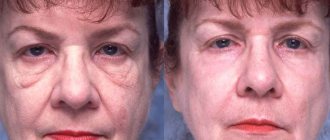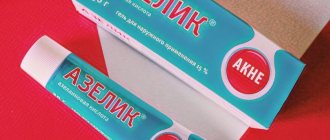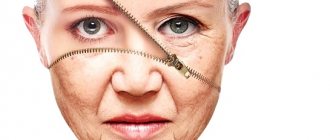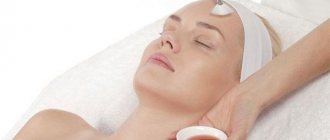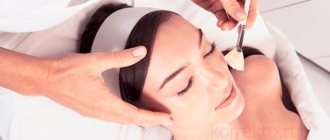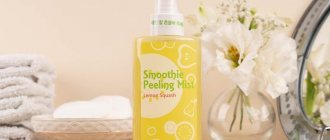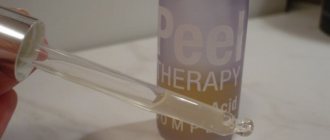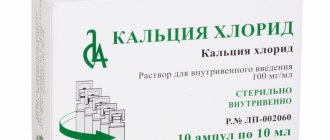Chemical peeling is iatrogenic damage to certain layers of the epidermis and/or dermis.
In response to damage, a huge amount of pro-inflammatory mediators, growth factors, and biologically active substances are released, which leads to the activation of protective regenerative mechanisms, an increase in the metabolic and mitotic activity of basal keratinocytes and fibroblasts. The expected effects of the chemical peeling procedure are improvement of the appearance of the skin: color, smoothing of the skin profile, improvement of micro- and macrorelief, activation of reparative processes, increased synthesis of epidermal lipids and extracellular structures of the dermal matrix. The effect depends more on the depth of skin damage and less on the chemical preparation. The stimulating effect of chemical peeling is indirect. This is the skin's reaction to inflammation that develops as a result of skin damage.
Classification
- Superficial peeling (within the stratum corneum) minimal inflammatory reaction, m/painful, the safest. AHA, aβ-complexes, phytic, Jaisner, 1-15% TCA.
- Median (within the Malpighian layer). Medium peeling is accompanied by necrosis of the Malpighian layer, with the development of a pronounced inflammatory reaction (hyperemia, edema) and severe peeling; the rehabilitation period is 7-14 days. Allows you to change (smooth) micro- and macrorelief. Recommended for the correction of superficial wrinkles, enlarged pores, post-acne, and stretch marks. 15-25% TCA, combined TCA + enzyme (papain), Blue peel, Krulig peeling, phenol.
- Deep (with damage to the papillary dermis)
The only type of peeling that allows you to correct wrinkles, a high risk of scarring, rehabilitation up to 1.5 years. 25-50% TCA, phenol up to 40% - the “gold standard” of peeling. The most effective, the most toxic. It has a selective cytotoxic effect on melanocytes - recommended for the correction of hyperpigmentation.
Skin care after the procedure
We would like to draw your attention to the fact that before and after the superficial peeling procedure you will need to follow several instructions from the cosmetologist. Your doctor may advise:
- Refrain from using decorative cosmetics;
- Regularly apply special creams and ointments to the skin of the face for several days;
- In the first 1-3 days, avoid visiting the sauna, swimming pool and gym.
Considering that superficial peeling eliminates the occurrence of an inflammatory reaction, no serious changes in lifestyle will follow. It must be remembered that the implementation of such procedures has a number of professional nuances. They can only be performed by doctors who have undergone special training.
Superficial chemical peeling AHA
When talking about superficial chemical peeling, we primarily mean peeling with AHA, or fruit acids.
The first mention of cutaneous use of AHA dates back to 1974. Van Scotch and Yu, studying the effect of various drugs for ichthyosis, found that glycolic acid is able to control the processes of keratinization of the epidermis, weakening the adhesion between corneocytes. Subsequently, the therapeutic effectiveness of ANA was established for all forms of hyperkeratosis.
The AHA group includes: glycolic, lactic, apple, tartaric, lemon
Mechanical facial peeling
This type of manual peeling is considered the easiest way to cleanse the face. The procedure involves mechanical removal of the top layer of the epidermis using abrasives. The preparations used contain hard granules to quickly eliminate dead cells. Such means include:
- Scrub. Available in the form of a gel or cream with abrasive particles. The product is applied to the face, after which it is washed off along with dead cells. It is important to try not to injure the skin during the scrubbing process.
- Gommage. Designed for cellular nutrition and regeneration. The product is a rolling cream with soft abrasive particles or fruit acids that dissolve during cleaning.
- Brushing (brossage) to exfoliate the dead layer of the epidermis. To perform the procedure, you need a special hard brush with synthetic bristles. The face is covered with abrasive paste, then massaged with a brush.
- Salt peeling. The procedure is performed using products containing table or sea salt, rich in macro- and microelements.
- Coral polishing. The products used during the procedure contain coral chips and plant components.
- Film masks for removing dead cells from the skin. The product is a special silicone film that is applied to the face and then removed along with the stratum corneum.
With the help of manual mechanical cleaning, impurities are removed from the surface layer, the skin becomes fresh, and shallow wrinkles are smoothed out.
We recommend
Laser aesthetic cosmetology: the perfect technique for an ideal appearance More
In the beauty salon, specialists perform medium mechanical peeling, which includes microcrystalline dermabrasion and diamond exfoliation. Using these procedures, minor scars, scars, slight pigmentation, and post-acne are eliminated.
Indications for use
Biological aging of the skin. Almost all types of peelings are used to correct signs of aging. The choice of one procedure or another is determined primarily by the severity of cosmetic defects. ANA peeling optimal age 23-30 years (prevention of aging), no correction of age-related changes. Number of procedures 4-6, ANA concentration 50-70% Additional components: antioxidants
Photoaging is changes in the skin under the influence of UV rays. 50-70% ANA, number of sessions 8. The most promising is the combination of ANA with antioxidants and whitening agents.
Pigmentation -
- dyschromia - 70% ANA, amount 8. Optimally αβ-complexes
- chloasma, hyperpigmentation - it is recommended to use AHA up to 50%, as inflammation can cause increased pigmentation. Pre-peel preparation is required to reduce the risk of increased hyperpigmentation, includes the use of phytic acid 3-10%, combined preparations of glycolic acid + kojic acid, ascorbic acid, glabridin, antioxidants that reduce inflammation are recommended, and the use of UV filters is mandatory. Number of sessions 8.
- Comedonal, papulopustular form of acne. Initially, the use of ANA for acne vulgaris was limited exclusively to the treatment of post-eruptive hyperpigmentation and scarring. This was the only method for correcting secondary skin changes in this disease, which is possible even against the background of unresolved inflammatory elements. Subsequent clinical observations showed that the use of this group of drugs significantly accelerated the relief of the inflammatory process and extended the time of remission
Medium chemical peels
TCA (15-25%) is a keratolytic, causing protein coagulation. Non-toxic substance.
When applied to the skin, TCA causes the formation of a frost effect. Depending on the depth of necrosis, the following types of frost effect are distinguished:
- Pink frost: “pointed” - throughout the entire depth of the stratum corneum; “clouds” - granular layer
- White (milky): translucent film - the border of the granular and spinous layer
- White deaf, compact: up to the basement membrane, dermal papillae
- Solid white with a yellowish/greenish tint: up to the reticular layer (there will be a scar in this place).
Choosing the type of facial peeling based on age and skin type
When choosing the type of superficial (or other) facial peeling in cosmetology, it is customary to take into account two important factors: the age of the client and the specifics of the problem.
Depending on the degree of skin aging, the optimal type of cleansing is selected:
- 21–25 years old. At this age there are no significant changes yet. Only pigmentation may appear. Experts recommend gommage or scrubbing, enzyme cleansing, and peeling using fruit acids.
- 25–35 years old. This period is characterized by the appearance of facial wrinkles, keratosis, and age spots. Cosmetologists recommend cryopilling, laser or superficial chemical peeling.
- 35–50 years old. At this age, changes in the condition of the skin become clearly visible: dull complexion, pronounced pigmentation, capillary network. Laser cleaning and vacuum peeling are recommended.
- More than 50 years. This period is characterized by the presence of many wrinkles and creases of varying depths. After 50 years, the skin needs deep chemical peeling and laser cleaning.
For mature facial skin after 40 years, cosmetologists recommend dermabrasion, mid-level professional laser or ultrasonic peeling.
- For oily skin, diamond peeling, coral mechanical or dry cleansing is suitable.
- For problem skin, salicylic or almond peels are performed.
Cosmetologists consider peelings to be an effective remedy that helps maintain skin health and renew it. Thanks to the procedure, skin tissue rejuvenation occurs quickly, skin tone increases, wrinkles are smoothed out.
If you perform peelings regularly, there will be no need for plastic surgery to restore and rejuvenate the skin.
The downside of these procedures is the risk of complications in the form of intense pigmentation, spider veins, and tissue scarring in the area of severely damaged or burned skin.
To avoid unforeseen consequences during cleansing or restoration, you need to contact trusted beauty salons. In addition, it is necessary to choose only high-quality drugs.
Why clients choose Veronika Herba Beauty and Health Center:
- This is a beauty center where you can take care of yourself at a reasonable cost, while your face and/or body will be treated not by an ordinary cosmetologist, but by one of the best cosmetologists in Moscow. This is a completely different, higher level of service!
- You can receive qualified help at any time convenient for you. The beauty center is open from 9:00 to 21:00, seven days a week. The main thing is to agree with your doctor in advance on the date and time of your appointment.
Sign up for a consultation with a specialist by phone +7 (495) 085-15-13
, and you will see for yourself!
Contraindications
Absolute:
- Dermatoses in the acute stage (especially herpes infection)
- IV,V,VI skin phototype
- Tendency to form hypertrophic and keloid scars
- Rehabilitation period after other cosmetic procedures (Botox - 14 days, microimplants - 1 week, laser resurfacing, dermabrasion - no earlier than 1 year)
- Pregnancy, nursing (painful procedure)
- Mentally labile patients.
- Thin, sensitive skin with reduced regeneration
Relative: nevi, rosacea, hypertrichosis, spring-summer period
Expected skin reactions occurring immediately after a chemical peel (1-14 days):
- Edema. Most often, swelling and pastiness develop with deep peels. With superficial peeling, swelling is moderate or absent. It develops on the first day after the procedure, reaches a maximum on the 3rd day, and disappears by the 5th day. The severity of edema varies for each patient; it most often develops in people with thin and loose skin. It is extremely rare that after deep peels, significant swelling of the eyelids, neck and upper chest may develop. But there is never any swelling of the upper respiratory tract or any systemic damage after a chemical peel. There is no need to prescribe special therapy for the treatment of edema. Prophylactic administration of steroids does not prevent the development of edema. Although a number of authors recommend the use of glucocorticoids in a short course, both intravenously (during the procedure) and orally for 5 days, because this can significantly reduce swelling. As a rule, cold compresses are used more often to prevent swelling of the eyelids.
- Hyperemia. With superficial and medium peels, the erythema is moderate and disappears by 3-4 days. With deep peeling, erythema may persist for up to 1-2 months after the procedure. The most pronounced erythema occurs after laser resurfacing and dermabrasion. It appears immediately after the procedure. After 7-10 days, its intensity decreases, but it can persist for up to several months. This is due to the fact that during these procedures the dermis is “exposed”.
- Darkening of the skin. After a TCA peel, the epidermis often turns dark brown. After 3 days, separation and exfoliation of the destroyed layers of skin begins, which reaches a maximum by 5-6 days and completely stops by 7-14 days. As a result, the regenerated new skin has a pink color. Αβ-peeling
A combination of glycolic and salicylic acids. It is a superficial-medium peeling. Incoming salicylic acid (keratolytic) potentiates the penetration of glycolic acid.
The technique is similar to AHA peeling. Brighter erythema after 15-20 seconds, intense burning, possible frost effect. Exposure up to 1-2 minutes. Indications: thick, porous skin, post-acne.
How to choose peeling depth
When selecting a peel, you need to evaluate:
- How deep is the problem you plan to deal with: above or below the basement membrane?
- Condition of skin barriers . How wealthy are they due to their skin condition/disease.
* For example, with inflamed acne or rosacea, the skin is often sensitive, and it is better to choose a superficial peel here.
Before assessing the depth of the problem in the skin, we will divide them into the three most common ones that are addressed to a cosmetologist:
1. Age-related changes and wrinkles
2. Acne and problem skin
3. Age spots
AGE CHANGES
The choice depends on the manifestations of age-related changes:
- Superficial wrinkles, hyperkeratosis, dry and dehydrated skin -> the optimal choice is superficial peeling with a pH of 3.5 - 2.5.
Acids will remove layers of horny masses and wrinkles, and professional pH will improve lymphatic drainage, hydration levels and increase immune function.
- Deep wrinkles - creases, sagging skin against the background of decreased cellular renewal and fibroblast activity -> medium peels .
DARK SPOTS
Before choosing the optimal peeling depth, you need to determine the depth of the pigment. It is necessary to be very careful in selecting and performing a lightening peel and prescribing additional home care products, because excessive trauma can provoke post-inflammatory pigmentation.
- Superficial diffuse pigmentation lies above the basement membrane - accordingly, superficial or superficial-medium peeling is suitable.
Ideally, choose a brightening peeling that contains not only acids, but also lightening substances.
- Deep pigmentation lies under the basement membrane - choose a medium peel with a pH of 1.5. It will provoke active lymphatic drainage and cellular renewal, washing out the pigment.
PROBLEM SKIN AND ACNE
And here you need to determine where the problem is located - at what level:
- On the surface - hyperkeratosis, papules, pustules, untidy skin, irritation.
In these cases, you need to work on the surface for good cleansing of excess horny masses, removal of colonies of pathogenic flora and restoration of the skin microbiome.
- Deep inflammatory elements
If the inflammation process is active and new acne elements appear regularly, peelings are not used!
In the presence of deep nodular rashes that do not resolve on their own or during home care, superficial-medium peels with a pH of 2.5-3.0 are recommended. They will eliminate the problem by improving lymphatic drainage: absorbing effect and stimulating the immune function of the skin.
Azelaic acid and other anti-acne substances are desirable in the formulations.

